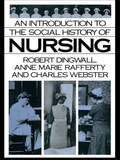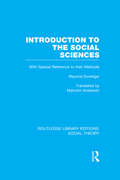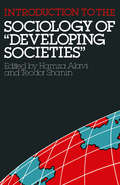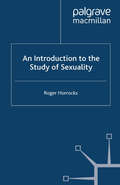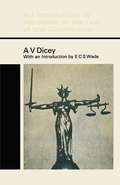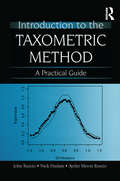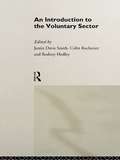- Table View
- List View
An Introduction to the Science of Deception and Lie Detection
by Chris N. StreetThis accessible book provides a foundational understanding of the science of deception and lie detection. Focusing on core issues for the field, it discusses classic and current psychological research into lying as well as theoretical approaches to understanding human lie detection. This book explores engaging questions around how people lie, how people make decisions about believing others, and how we can detect deception. Each chapter is clearly structured to support students of all levels by summarising content, presenting key research, and systematically evaluating findings. Chapters explore topics including some of the most promising current lie detection techniques, how and why people lie, how lying develops in children, and whether unconscious thinking can boost lie detection accuracy. Providing an overview of key issues in deception, this book will be of great interest to students and lecturers in the field of deception and lie detection, as well as anyone generally interested in this fascinating field of research.
Introduction to the Science Popularization Industry
by Fujun Ren Yizhong Zhang Guangbin LiuThis book systematically introduces the popular science industry. It firstly summarizes the social basis and research status of the development of contemporary science popularization industry and also elaborates on the basic theory and main forms of science popularization industry. The most important feature of this book is its focus on the practice and case study of the development of science popularization industry in China. Meanwhile, it analyzes the development of science popularization industry in China from four perspectives: the basis and conditions, the current situation and countermeasures, the main promotion tasks, and the policy suggestions for promotion. The book analyzes the development trend of science popularization industry in China. It can be used as a reference book for science popularization practitioners and enthusiast to learn and understand the theory and practice of science popularization industry. It can also be used as a textbook for the cultivation and training of science popularization talents.
An Introduction to the Social Geography of India: Concepts, Problems and Prospects
by Asif Ali HemantThis book discusses the significance of social geography, a multidimensional sub-discipline of georgraphy encompassing social health, social security and social ethos. It presents the socio-spatial dynamics of the population in India through an understanding of the various issues related to migration, urbanisation, unemployment, poverty and public health. With a thorough analysis of various social indicators relating to health, education, income and employment, the volume presents a detailed picture of the social geography of India. It discusses in detail, The origin, nature and scope of social geography, its relations with other social sciences and applications The nature and importance of social well-being along with welfare geography and the role of welfare state in ensuring social well-being The population of India and its attributes The status and spatial patterns of various social indicators relating to health, education and income and employment The composite indices which aggregate several social indicators such as the Human Development Index, Multidimensional Poverty Index and Sustainable Developmental Goals Index in the context of India. This comprehensive book will be useful for students, researchers and teachers of social geography, human geography, population geography, demography and sociology. The book can also be used by students preparing for exams like civil services, UPSC, PSC and other competitive exams.
An Introduction to the Social Geography of India: Concepts, Problems and Prospects
by Asif Ali HemantThis book discusses the significance of social geography, a multidimensional sub-discipline of georgraphy encompassing social health, social security and social ethos. It presents the socio-spatial dynamics of the population in India through an understanding of the various issues related to migration, urbanisation, unemployment, poverty and public health. With a thorough analysis of various social indicators relating to health, education, income and employment, the volume presents a detailed picture of the social geography of India. It discusses in detail, The origin, nature and scope of social geography, its relations with other social sciences and applications The nature and importance of social well-being along with welfare geography and the role of welfare state in ensuring social well-being The population of India and its attributes The status and spatial patterns of various social indicators relating to health, education and income and employment The composite indices which aggregate several social indicators such as the Human Development Index, Multidimensional Poverty Index and Sustainable Developmental Goals Index in the context of India. This comprehensive book will be useful for students, researchers and teachers of social geography, human geography, population geography, demography and sociology. The book can also be used by students preparing for exams like civil services, UPSC, PSC and other competitive exams.
An Introduction to the Social History of Nursing
by Robert Dingwall Anne Marie Rafferty Charles WebsterIn recent years the study of nursing history in Britain has been transformed by the application of concepts and methods from the social sciences to original sources. The myths and legends which have grown up through a century of anecdotal writing have been chipped away to reveal the complex story of an occupation shaped and reshaped by social and technological change. Most of the work has been scattered in monographs, journals and edited collections. The skills of a social historian, a sociologist and a graduate nurse have been brought together to rethink the history of modern nursing in the light of the latest scholarship. The account starts by looking at the type of nursing care available in 1800. This was usually provided by the sick person's family or household servants. It traces the interdependent growth of general nursing and the modern hospital and examines the separate origins and eventual integration of mental nursing, district nursing, health visiting and midwifery. It concludes with reflections on the prospects for nursing in the year 2000.
An Introduction to the Social History of Nursing
by Robert Dingwall Anne Marie Rafferty Charles WebsterIn recent years the study of nursing history in Britain has been transformed by the application of concepts and methods from the social sciences to original sources. The myths and legends which have grown up through a century of anecdotal writing have been chipped away to reveal the complex story of an occupation shaped and reshaped by social and technological change. Most of the work has been scattered in monographs, journals and edited collections. The skills of a social historian, a sociologist and a graduate nurse have been brought together to rethink the history of modern nursing in the light of the latest scholarship. The account starts by looking at the type of nursing care available in 1800. This was usually provided by the sick person's family or household servants. It traces the interdependent growth of general nursing and the modern hospital and examines the separate origins and eventual integration of mental nursing, district nursing, health visiting and midwifery. It concludes with reflections on the prospects for nursing in the year 2000.
Introduction to the Social Sciences (Routledge Library Editions: Social Theory)
by Maurice DuvergerProfessor Duverger at last provides the student with an overall view of the methodology of the social sciences. He briefly traces the origin of the notion of a social science, showing how it emerged from social philosophy. Its essential elements and pre-conditions are described; the splintering of social science into specialist disciplines is explained, and the need for a general sociology confirmed. The techniques of observation used by social scientists are dealt with in some detail and the unity of the social sciences is illustrated by examples of the universal application of these techniques. Documentary evidence in its various forms are described along with the basic analytical techniques, including quantitative methods and content analysis. Other methods of gathering information through polls, interviews, attitude scales and participant observation are all described. Professor Duverger brings together the different kinds of analysis used to assess the information thus gathered. Arguing that observing and theorizing are not two different stages or levels of research, he examines the practical value and difficulties of general sociological theories, partial theories and models and working hypotheses. He both describes and assesses the limitations of experiment and the scope of comparative methods in the social sciences. He then gives elementary instructions for using and assessing the value of mathematical techniques. The possibilities of presenting social phenomena through graphs and charts are also explored. There are useful book lists and diagrams.
Introduction to the Social Sciences (Routledge Library Editions: Social Theory)
by Maurice DuvergerProfessor Duverger at last provides the student with an overall view of the methodology of the social sciences. He briefly traces the origin of the notion of a social science, showing how it emerged from social philosophy. Its essential elements and pre-conditions are described; the splintering of social science into specialist disciplines is explained, and the need for a general sociology confirmed. The techniques of observation used by social scientists are dealt with in some detail and the unity of the social sciences is illustrated by examples of the universal application of these techniques. Documentary evidence in its various forms are described along with the basic analytical techniques, including quantitative methods and content analysis. Other methods of gathering information through polls, interviews, attitude scales and participant observation are all described. Professor Duverger brings together the different kinds of analysis used to assess the information thus gathered. Arguing that observing and theorizing are not two different stages or levels of research, he examines the practical value and difficulties of general sociological theories, partial theories and models and working hypotheses. He both describes and assesses the limitations of experiment and the scope of comparative methods in the social sciences. He then gives elementary instructions for using and assessing the value of mathematical techniques. The possibilities of presenting social phenomena through graphs and charts are also explored. There are useful book lists and diagrams.
Introduction to the Sociology of Development
by Andrew WebsterAn introduction to the latest debates in the sociology of development, linking theoretical and empirical issues of social change through reference to the Third World. This book covers conceptions of modernisation and underdevelopment and points to new attempts at their synthesis and explores the policy implications of different development models.
Introduction to the Sociology of Development
by Andrew WebsterThis text provides a comprehensive introduction to the latest debates in the sociology of development, linking theoretical and empirical issues of social change primarily though not exclusively through reference to the Third World. This book covers general conceptions of modernisation and underdevelopment and points to new attempts at their synthesis as well as exploring the policy implications of different development models.
An Introduction to the Sociology of Health & Illness
by Kevin White"Kevin White guides us through the many reasons for the centrality of health showing clearly that health and illness are the products not just of our biology but of the society into which we are born. He expertly draws on the works of Parsons, Marx, Foucault and feminist writers to provide an authoritative analysis of the social nature of health. " - Ray Fitzpatrick, University of Oxford "I have used this book for many years because it is so well written, and it is easy for the students to understand. " - Julianne Law, Bangor University "An excellent introductory text to help the students to begin to critically analyse different perspectives on health. " - Debbie Chittenden, University of Bolton This is a new edition of the best-selling textbook for students of the sociology of health and illness. Free of jargon, intuitive about student needs and well versed in course requirements, Kevin White's book is used widely across both health and sociology schools.
An Introduction to the Sociology of Health & Illness
by Kevin White"Kevin White guides us through the many reasons for the centrality of health showing clearly that health and illness are the products not just of our biology but of the society into which we are born. He expertly draws on the works of Parsons, Marx, Foucault and feminist writers to provide an authoritative analysis of the social nature of health." - Ray Fitzpatrick, University of Oxford "I have used this book for many years because it is so well written, and it is easy for the students to understand." - Julianne Law, Bangor University "An excellent introductory text to help the students to begin to critically analyse different perspectives on health." - Debbie Chittenden, University of Bolton This is a new edition of the best-selling textbook for students of the sociology of health and illness. Free of jargon, intuitive about student needs and well versed in course requirements, Kevin White's book is used widely across both health and sociology schools.
An Introduction to the Study of Sexuality
by R. HorrocksThis book examines some of the ways in which sexuality has been described and interpreted in the West. The main models examined are: the Christian view of sex as sinful; the psychoanalytical model, including such notions as the sexual drive, infantile sexuality, the Oedipus complex, and the distinction between male and female sexuality; the 'social construction' model, which proposes that 'sexuality' is a modern concept; and the links between sexuality and spirituality. There is also some consideration of feminist and gay approaches to sexuality, and the complicated subject of male sexuality.
An Introduction to the Study of the Law of the Constitution
by A.V. DiceyA starting point for the study of the English Constitution and comparative constitutional law, The Law of the Constitution elucidates the guiding principles of the modern constitution of England: the legislative sovereignty of Parliament, the rule of law, and the binding force of unwritten conventions.
An Introduction to the Study of the Nervous System
by E. E. Hewer G. M. SandesAn Introduction to the Study of the Nervous System covers topics about the minute structure and functions of the nervous system. The book discusses the minute and gross anatomy of the various parts of the nervous system; the degenerative and regenerative changes following section of the nerves; and the descending and ascending tracts of the spinal cord. The text then describes the cerebellar connections; the deep connections of the cranial nerves; and the microscopic structure of the cortex of the cerebellum and of the cerebrum. The distribution, source, circulation and absorption, pressure, and normal composition of the cerebrospinal fluid and the parts and functions of the autonomic nervous system are also considered. The book further tackles the normal physiology of the sensory and motor paths; the results of interference with the general sensory path at various levels; and the visual path and interference therewith. The text also discusses the cochlear and olfactory paths and the interference therewith and the levels of integration and mechanism of coordinated muscular movement. Students taking courses related to neurology will find the book useful.
Introduction to the Taxometric Method: A Practical Guide
by Nick Haslam John Ruscio Ayelet Meron RuscioIntroduction to the Taxometric Method is a user-friendly, practical guide to taxometric research. Drawing from both classic and contemporary research, it provides a comprehensive introduction to the method. With helpful tools and guidance, the book is intended to teach those new to the method, as well as those already familiar with it, tips on how to conduct and evaluate taxometric investigations. The book covers a broad range of analytic techniques, describing their logic and implementation as well as what is known about their performance from systematic study. The book opens with the background material essential to understanding the research problems that the taxometric method addresses. The authors then explain the data requirements of taxometric analysis, the logic of each procedure, factors that can influence results and lead to misinterpretations, suggestions for choosing the best procedures, and methodological safeguards to prevent erroneous conclusions. Illustrative examples of each procedure and consistency test demonstrate how to perform analyses and interpret results using a variety of data sets. A checklist of conceptual and methodological issues that should be addressed in any investigation is included. The accompanying CD provides a variety of programs for performing taxometric analyses along with simulations and analyses of data sets. Introduction to the Taxometric Method is ideal for researchers and students conducting or evaluating taxometric studies in the social and behavioral sciences, especially those in clinical and personality psychology, as well as those in the physical sciences, education, biology, and beyond. The book also serves as a text for courses on this method, or as a supplement in psychological assessment, statistics, or research methods courses. Familiarity with taxometrics is not assumed.
Introduction to the Taxometric Method: A Practical Guide
by Nick Haslam John Ruscio Ayelet Meron RuscioIntroduction to the Taxometric Method is a user-friendly, practical guide to taxometric research. Drawing from both classic and contemporary research, it provides a comprehensive introduction to the method. With helpful tools and guidance, the book is intended to teach those new to the method, as well as those already familiar with it, tips on how to conduct and evaluate taxometric investigations. The book covers a broad range of analytic techniques, describing their logic and implementation as well as what is known about their performance from systematic study. The book opens with the background material essential to understanding the research problems that the taxometric method addresses. The authors then explain the data requirements of taxometric analysis, the logic of each procedure, factors that can influence results and lead to misinterpretations, suggestions for choosing the best procedures, and methodological safeguards to prevent erroneous conclusions. Illustrative examples of each procedure and consistency test demonstrate how to perform analyses and interpret results using a variety of data sets. A checklist of conceptual and methodological issues that should be addressed in any investigation is included. The accompanying CD provides a variety of programs for performing taxometric analyses along with simulations and analyses of data sets. Introduction to the Taxometric Method is ideal for researchers and students conducting or evaluating taxometric studies in the social and behavioral sciences, especially those in clinical and personality psychology, as well as those in the physical sciences, education, biology, and beyond. The book also serves as a text for courses on this method, or as a supplement in psychological assessment, statistics, or research methods courses. Familiarity with taxometrics is not assumed.
An Introduction to the US Health Care Industry: Balancing Care, Cost, and Access
by David S. GuzickFor decades, the United States has been faced with a puzzling problem: Despite spending much more money per capita on health care than any other developed nation, its population suffers from notoriously poorer health. In comparison with 10 other high-income nations, in fact, the US has the lowest life expectancy at birth, the highest rates of infant and neonatal mortality, and the most inequitable access to physicians when adjusted for need. In An Introduction to the US Health Care Industry, Dr. David S. Guzick takes an in-depth look at this troubling issue. Bringing to bear his unique background as a physician, economist, former University of Rochester medical school dean, and former president of the University of Florida Health System, Dr. Guzick shows that what we commonly refer to as the US health care "system" is actually an industry forged by a unique collection of self-interested and disjointed stakeholders. He argues that the assumptions underlying well-functioning markets do not align with health care. The resulting market imperfections, combined with entrenched industry stakeholders, have led to a significant imbalance of care, cost, and access.Using a nontechnical framework, Dr. Guzick introduces readers to the economic principles behind the function—and dysfunction—of our health care industry. He shows how the market-based approach could be expected to remedy these problems while detailing the realities of imperfections, regulations, and wealth inequality on those functions. He also analyzes how this industry developed, presenting the conceptual underpinnings of the health care industry while detailing its history and tracing the creation and entrenchment of the current federation of key stakeholders—government, insurance companies, hospitals, doctors, employers, and drug and device manufacturers. In the final section of the book, Dr. Guzick looks to the future, describing the prevention, innovation, and alternative financing models that could help to rebalance the priorities of care, cost, and access that Americans need.
An Introduction to the US Health Care Industry: Balancing Care, Cost, and Access
by David S. GuzickFor decades, the United States has been faced with a puzzling problem: Despite spending much more money per capita on health care than any other developed nation, its population suffers from notoriously poorer health. In comparison with 10 other high-income nations, in fact, the US has the lowest life expectancy at birth, the highest rates of infant and neonatal mortality, and the most inequitable access to physicians when adjusted for need. In An Introduction to the US Health Care Industry, Dr. David S. Guzick takes an in-depth look at this troubling issue. Bringing to bear his unique background as a physician, economist, former University of Rochester medical school dean, and former president of the University of Florida Health System, Dr. Guzick shows that what we commonly refer to as the US health care "system" is actually an industry forged by a unique collection of self-interested and disjointed stakeholders. He argues that the assumptions underlying well-functioning markets do not align with health care. The resulting market imperfections, combined with entrenched industry stakeholders, have led to a significant imbalance of care, cost, and access.Using a nontechnical framework, Dr. Guzick introduces readers to the economic principles behind the function—and dysfunction—of our health care industry. He shows how the market-based approach could be expected to remedy these problems while detailing the realities of imperfections, regulations, and wealth inequality on those functions. He also analyzes how this industry developed, presenting the conceptual underpinnings of the health care industry while detailing its history and tracing the creation and entrenchment of the current federation of key stakeholders—government, insurance companies, hospitals, doctors, employers, and drug and device manufacturers. In the final section of the book, Dr. Guzick looks to the future, describing the prevention, innovation, and alternative financing models that could help to rebalance the priorities of care, cost, and access that Americans need.
Introduction to the Voluntary Sector
by Rodney Hedley Colin Rochester Justin Davis SmithIn the 1990s the voluntary and charity sector is being forced to become an increasingly important provider of health and social welfare in Britain. How can it respond to this pressure, who is running it and how should it be managed? As well as offering a full overview of the voluntary sector the editors and contributors: examine its history and importance within welfare provision explore its current position and responsibilities offer practical guidance for and analysis of the issues facing the voluntary sector today including its legal framework in the UK and EU, fundraising management and accountability. An Introduction to the Voluntary Sector will be invaluable reading to all students and lecturers of social policy and organisational studies as well as to professional policy-makers and voluntary sector personnel.
Introduction to the Voluntary Sector
by Rodney Hedley Colin Rochester Justin Davis SmithIn the 1990s the voluntary and charity sector is being forced to become an increasingly important provider of health and social welfare in Britain. How can it respond to this pressure, who is running it and how should it be managed? As well as offering a full overview of the voluntary sector the editors and contributors: examine its history and importance within welfare provision explore its current position and responsibilities offer practical guidance for and analysis of the issues facing the voluntary sector today including its legal framework in the UK and EU, fundraising management and accountability. An Introduction to the Voluntary Sector will be invaluable reading to all students and lecturers of social policy and organisational studies as well as to professional policy-makers and voluntary sector personnel.
Introduction to the Work of Marcel Mauss
by Claude Levi-StraussFirst published in 1987. Routledge is an imprint of Taylor & Francis, an informa company.
Introduction to the Work of Marcel Mauss
by Claude Levi-StraussFirst published in 1987. Routledge is an imprint of Taylor & Francis, an informa company.
An Introduction To The World-system Perspective: Second Edition
by Thomas R ShannonIn this second edition, Thomas Shannon extends his overall assessment of the world-system perspective to include the new theoretical and empirical developments in the field since 1989. Incorporating most leading arguments of world-system theorists, he addresses the fall of the Eastern Bloc as well as such current topics as relations with indigenous peoples, cultural analysis, methodology, women, and race. He discusses world-system analysis as a flexible and changing paradigm and considers future directions in the field.This advanced undergraduate and graduate-level text is the only book that provides an introduction to the world-system approach to the study of modern social change. Tracing the general antecedents of world-system theory and describing its major tenets, Shannon focuses on the basic characteristics and components of the world-system and the economic and political relationships within it. He characterizes changes within the system, including social and economic trends, cycles of great power leadership, and events and policies by which states rise or fall in importance.



